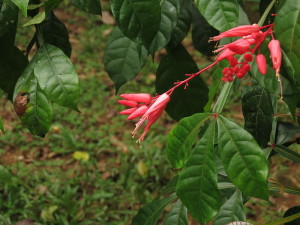Quassia is a plant. The wood is used as medicine.
Contents
Uses
Traditionally, Q. amara is used as a digestive, to treat fever, and against hair parasites (lice, fleas) and Mosquito larvae in ponds (and do not harm the fishes).
The component Simalikalactone D was identified as an antimalarial. The preparation of a tea out of young leaves is used traditionally in French Guyana.
Benefits
Quassia is used for treating an eating disorder called anorexia, indigestion, constipation, and fever. It is also used to rid the intestines of various kinds of worms; as a tonic or purgative; and as a mouthwash.
Some people apply quassia directly to the scalp for lice.
Rectally, quassia is used for treating worm infestations.
In manufacturing, quassia is used to flavor foods, beverages, lozenges, and laxatives. The bark and wood have been used as an insecticide.
Cautions
Quassia is LIKELY SAFE when taken by mouth in food amounts. But quassia is POSSIBLY UNSAFE when taken by mouth in medicinal amounts. It can cause side effects such as irritation of the mouth, throat, and digestive tract along with nausea and vomiting. In very large doses, it could cause abnormal heart function; however, most people throw up before they get a high enough dose to cause heart problems. Long-term use can cause vision changes and blindness.
Quassia is POSSIBLY SAFE when used on the skin.
Special Precautions & Warnings:
Pregnancy and breast-feeding: Quassia is LIKELY UNSAFE when taken by mouth during pregnancy or breast-feeding. It can cause cell damage and nausea.
There is not enough reliable information about the safety of applying quassia to the skin or scalp you are pregnant or breast-feeding. Stay on the safe side and avoid use.
Digestive tract problems or diseases, such as stomach or intestinal ulcers, Crohn’s disease, infections, and many other conditions: In large amounts quassia can irritate the digestive tract. Don’t use it if you have one of these conditions.
Interactions
- Digoxin (Lanoxin) interacts with QUASSIA
Quassia is a type of laxative called a stimulant laxative. Stimulant laxatives can decrease potassium levels in the body. Low potassium levels can increase the risk of side effects of digoxin (Lanoxin). - Water pills (Diuretic drugs) interacts with QUASSIA
Quassia is a laxative. Some laxatives can decrease potassium in the body. “Water pills” can also decrease potassium in the body. Taking quassia along with “water pills” might decrease potassium in the body too much.
Some “water pills” that can decrease potassium include chlorothiazide (Diuril), chlorthalidone (Thalitone), furosemide (Lasix), hydrochlorothiazide (HCTZ, HydroDiuril, Microzide), and others.
- Antacids interacts with QUASSIA
Antacids are used to decrease stomach acid. Quassia may increase stomach acid. By increasing stomach acid, quassia might decrease the effectiveness of antacids. Some antacids include calcium carbonate (Tums, others), dihydroxyaluminum sodium carbonate (Rolaids, others), magaldrate (Riopan), magnesium sulfate (Bilagog), aluminum hydroxide (Amphojel), and others. - Medications that decrease stomach acid (H2-Blockers) interacts with QUASSIA
Quassia might increase stomach acid. By increasing stomach acid, quassia might decrease the effectiveness of some medications that decrease stomach acid, called H2-Blockers.
Some medications that decrease stomach acid include cimetidine (Tagamet), ranitidine (Zantac), nizatidine (Axid), and famotidine (Pepcid). - Medications that decrease stomach acid (Proton pump inhibitors) interacts with QUASSIA
Quassia might increase stomach acid. By increasing stomach acid, quassia might decrease the effectiveness of medications that are used to decrease stomach acid, called proton pump inhibitors.
Some medications that decrease stomach acid include omeprazole (Prilosec), lansoprazole (Prevacid), rabeprazole (Aciphex), pantoprazole (Protonix), and esomeprazole (Nexium).
Other names
Amargo, Bitter-Ash, Bitter Wood, Bitterwood, Bois Amer, Cuasia, Écorce de Quassia, Jamaican Quassia, Palo de Cuasia, Pao Tariri, Picrasma, Picrasma excelsa, Quassia amara, Quassia Amer, Quassia Bark, Quassia de Jamaïque, Quassia de Surinam, Ruda, Surinam Quassia, Surinam Wood
References
Source: Wikipedia, https://en.wikipedia.org/wiki/Quassia_amara

